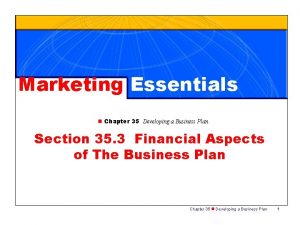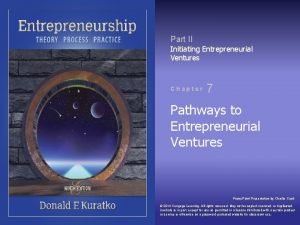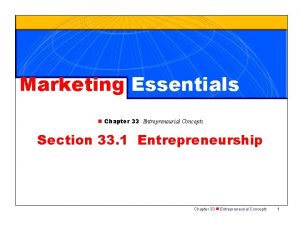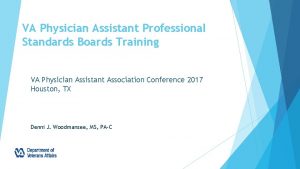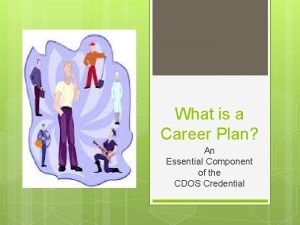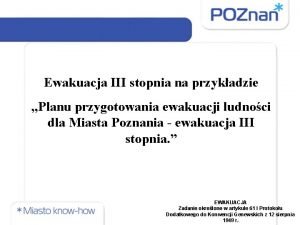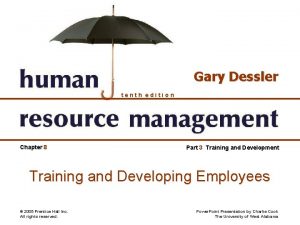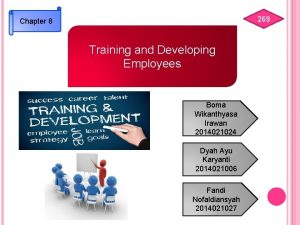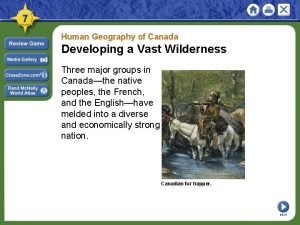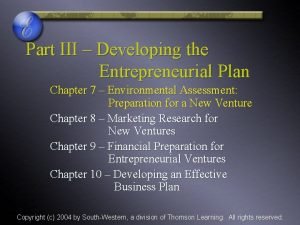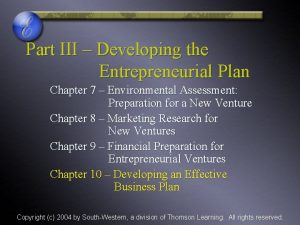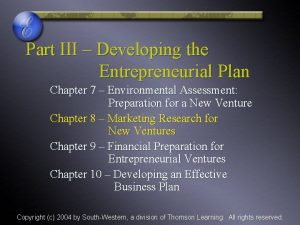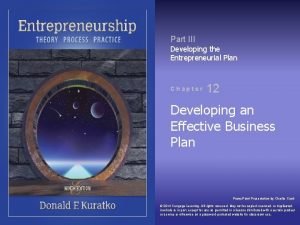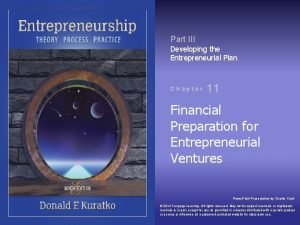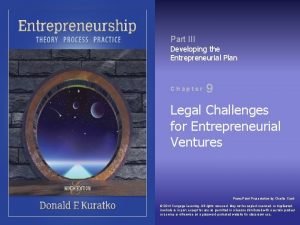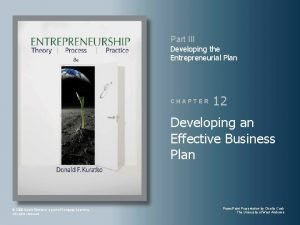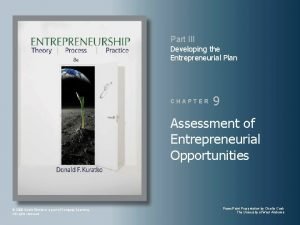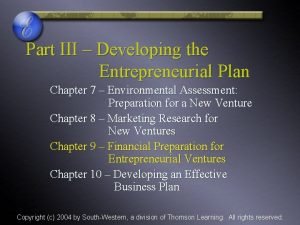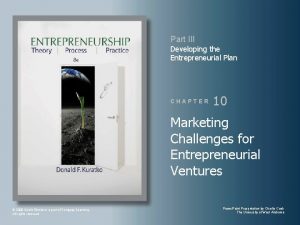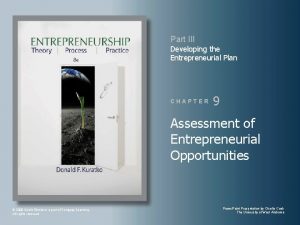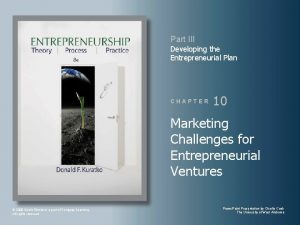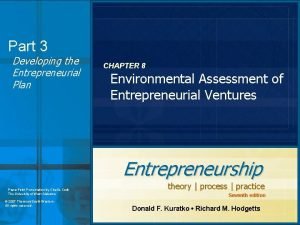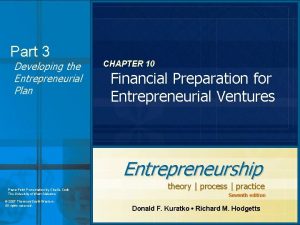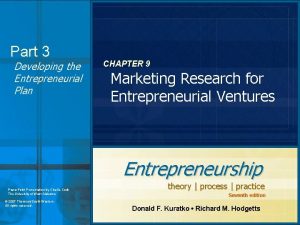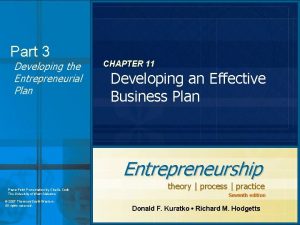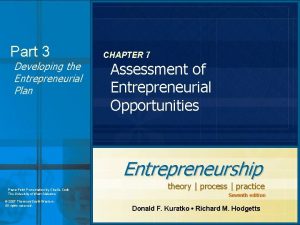Part III Developing the Entrepreneurial Plan Chapter 9
















































- Slides: 48

Part III Developing the Entrepreneurial Plan Chapter 9 Legal Challenges for Entrepreneurial Ventures Power. Point Presentation by Charlie Cook © 2014 Cengage Learning. All rights reserved. May not be copied, scanned, or duplicated, in whole or in part, except for use as permitted in a license distributed with a certain product or service or otherwise on a password-protected website for classroom use.

Chapter Objectives 1. To introduce the importance of legal issues to entrepreneurs 2. To examine patent protection, including definitions and preparation 3. To review copyrights and their relevance to entrepreneurs 4. To study trademarks and their impact on new ventures 5. To examine the legal forms of organization—sole proprietorship, partnership, and corporation 6. To illustrate the advantages and disadvantages of each of these three legal forms © 2014 Cengage Learning. All rights reserved. May not be copied, scanned, or duplicated, in whole or in part, except for use as permitted in a license distributed with a certain product or service or otherwise on a password-protected website for classroom use. 9– 2

Chapter Objectives (cont’d) 7. To explain the nature of the limited partnership and limited liability partnerships (LLPs) 8. To examine how an S corporation works 9. To define the additional classifications of corporations, including limited liability companies (LLCs), B corporations, and low-profit, limited liability companies (L 3 Cs) 10. To present the major segments of the bankruptcy law that apply to entrepreneurs © 2014 Cengage Learning. All rights reserved. May not be copied, scanned, or duplicated, in whole or in part, except for use as permitted in a license distributed with a certain product or service or otherwise on a password-protected website for classroom use. 9– 3

Legal Challenges for the Entrepreneurial Venture Inception of the Venture The Ongoing Venture Legal Concepts Growth and Continuity of the Venture © 2014 Cengage Learning. All rights reserved. May not be copied, scanned, or duplicated, in whole or in part, except for use as permitted in a license distributed with a certain product or service or otherwise on a password-protected website for classroom use. 9– 4

Major Legal Concepts and Entrepreneurial Ventures I. Inception of an Entrepreneurial Venture A. Laws governing intellectual property 1. Patents 2. Copyrights 3. Trademarks B. Forms of business organization 1. 2. 3. 4. C. D. E. Sole proprietorship Partnership Corporation Franchise Tax considerations Capital formation Liability questions © 2014 Cengage Learning. All rights reserved. May not be copied, scanned, or duplicated, in whole or in part, except for use as permitted in a license distributed with a certain product or service or otherwise on a password-protected website for classroom use. 9– 5

Major Legal Concepts and Entrepreneurial Ventures II. Ongoing Venture: Business Development and Transactions A. Personnel Law 1. 2. 3. Hiring and firing policies Equal Employment Opportunity Commission Collective bargaining B. Contract Law 1. Legal contracts 2. Sales contracts 3. Leases © 2014 Cengage Learning. All rights reserved. May not be copied, scanned, or duplicated, in whole or in part, except for use as permitted in a license distributed with a certain product or service or otherwise on a password-protected website for classroom use. 9– 6

Major Legal Concepts and Entrepreneurial Ventures III. Growth and Continuity of a Successful Entrepreneurial Venture A. Tax considerations 1. 2. 3. Federal, state, and local Payroll Incentives B. Governmental regulations 1. Zoning (property) 2. Administrative agencies (regulatory) 3. Consumer law C. Continuity of ownership rights 1. Property laws and ownership 2. Wills, trusts, and ownership 3. Bankruptcy © 2014 Cengage Learning. All rights reserved. May not be copied, scanned, or duplicated, in whole or in part, except for use as permitted in a license distributed with a certain product or service or otherwise on a password-protected website for classroom use. 9– 7

Intellectual Property Protection: Patents • Patent Ø Provides the owner with exclusive rights to hold, transfer, and license the production and sale of the product or process as an intellectual property right. Ø Design patents last for 14 years; all others last for 20 years. • What Items Qualify for Patent Protection? Ø Processes, machines, products, plants, compositions of elements (chemical compounds), and improvements on already existing items. © 2014 Cengage Learning. All rights reserved. May not be copied, scanned, or duplicated, in whole or in part, except for use as permitted in a license distributed with a certain product or service or otherwise on a password-protected website for classroom use. 9– 8

Securing a Patent • Rule 1: Pursue patents that are broad, are commercially significant, and offer a strong position. • Rule 2: Prepare a patent plan in detail. • Rule 3: Have your actions relate to your original patent plan. • Rule 4: Establish an infringement budget. • Rule 5: Evaluate the patent plan strategically. © 2014 Cengage Learning. All rights reserved. May not be copied, scanned, or duplicated, in whole or in part, except for use as permitted in a license distributed with a certain product or service or otherwise on a password-protected website for classroom use. 9– 9

Securing a Patent: The Application • Patent Application 1. Specification: the text of a patent and may include any accompanying illustrations. a. An introduction explaining why the invention will be useful. b. A description of prior art considered similar to the invention. c. A summary of the essence of the technology/invention, its differences from prior art and requisite features. d. A description of the invention, including anything remotely relevant, reference to variations, and number bounds. e. Examples and/or experimental results, in full detail. 2. Claims: a series of short paragraphs, each of which identifies a particular feature or combination of features that is protected by the patent. © 2014 Cengage Learning. All rights reserved. May not be copied, scanned, or duplicated, in whole or in part, except for use as permitted in a license distributed with a certain product or service or otherwise on a password-protected website for classroom use. 9– 10

Figure 9. 1 The Patent Process: From Application to Allowance and Issue Continued on following slide Source: United States Patent Office, 2012. © 2014 Cengage Learning. All rights reserved. May not be copied, scanned, or duplicated, in whole or in part, except for use as permitted in a license distributed with a certain product or service or otherwise on a password-protected website for classroom use. 9– 11

Figure 9. 1 The Patent Process: From Application to Allowance and Issue (cont’d) Continued on following slide Source: United States Patent Office, 2012. © 2014 Cengage Learning. All rights reserved. May not be copied, scanned, or duplicated, in whole or in part, except for use as permitted in a license distributed with a certain product or service or otherwise on a password-protected website for classroom use. 9– 12

Figure 9. 1 The Patent Process: From Application to Allowance and Issue (cont’d) Source: United States Patent Office, 2012. © 2014 Cengage Learning. All rights reserved. May not be copied, scanned, or duplicated, in whole or in part, except for use as permitted in a license distributed with a certain product or service or otherwise on a password-protected website for classroom use. 9– 13

Intellectual Property Protection: Copyrights • Copyright Ø Provides exclusive rights to creative individuals for the protection of their literary or artistic productions. Ø Duration: life of the author plus 70 years. • The copyright owner has the rights to: Ø Reproduce the work Ø Prepare derivative works based on it Ø Distribute copies of the work by sale or otherwise Ø Perform the work publicly Ø Display the work publicly Ø Sell or transfer individual rights © 2014 Cengage Learning. All rights reserved. May not be copied, scanned, or duplicated, in whole or in part, except for use as permitted in a license distributed with a certain product or service or otherwise on a password-protected website for classroom use. 9– 14

Intellectual Property Protection: Copyrights • Copyright Protection Ø The material must be in a tangible form so it can be communicated or reproduced. Ø It also must be the author’s own work and thus the product of his or her skill or judgment. Ø Formal registration of a copyright is with the Copyright Office of the Library of Congress. © 2014 Cengage Learning. All rights reserved. May not be copied, scanned, or duplicated, in whole or in part, except for use as permitted in a license distributed with a certain product or service or otherwise on a password-protected website for classroom use. 9– 15

Copyrights (cont’d) • Fair Use Doctrine Ø Reproduction of a copyright work for purposes such as criticism, comment, news reporting, teaching (including multiple copies for classroom use), scholarship, or research is not an infringement of copyright. • Protected Ideas? Ø The Copyright Act specifically excludes copyright protection for any “idea, procedure, process, system, method of operation, concept, principle, or discovery, regardless of the form in which it is described, explained, illustrated, or embodied. ” © 2014 Cengage Learning. All rights reserved. May not be copied, scanned, or duplicated, in whole or in part, except for use as permitted in a license distributed with a certain product or service or otherwise on a password-protected website for classroom use. 9– 16

Intellectual Property Protection: Trademarks • Trademark Ø A distinctive name, mark, symbol, or motto identified with a company’s product(s) and registered at the Patent and Trademark Office • Advantages of Trademark Registration Ø Nationwide constructive notice of the owner’s right to use the mark Ø Bureau of Customs protection against importers using the mark Ø Incontestability of the mark after five years © 2014 Cengage Learning. All rights reserved. May not be copied, scanned, or duplicated, in whole or in part, except for use as permitted in a license distributed with a certain product or service or otherwise on a password-protected website for classroom use. 9– 17

Intellectual Property Protection: Trademarks • Trademark Duration Ø Current registrations are good for 10 years with the possibility for continuous renewal every 10 years. Ø A trademark may be invalidated in four specific ways: • Cancellation proceedings • Cleaning-out procedure • Abandonment • Generic meaning © 2014 Cengage Learning. All rights reserved. May not be copied, scanned, or duplicated, in whole or in part, except for use as permitted in a license distributed with a certain product or service or otherwise on a password-protected website for classroom use. 9– 18

Trademarks (cont’d) • Avoiding the Trademark Pitfalls Ø Rule 1: Never select a corporate name or a mark without first doing a trademark search. Ø Rule 2: If your attorney says you have a potential problem with a mark, trust his or her judgment. Ø Rule 3: Seek a coined or a fanciful name or mark before you settle for a descriptive or a highly suggestive one. Ø Rule 4: Whenever marketing or other considerations dictate the use of a name or a mark that is highly suggestive of the product, select a distinctive logotype for the descriptive or suggestive words. Ø Rule 5: Avoid abbreviations and acronyms wherever possible, and when no alternative is acceptable, select a distinctive logotype in which the abbreviation or acronym appears. © 2014 Cengage Learning. All rights reserved. May not be copied, scanned, or duplicated, in whole or in part, except for use as permitted in a license distributed with a certain product or service or otherwise on a password-protected website for classroom use. 9– 19

Trade Secrets • Trade Secret Ø Business processes and information that cannot be patented, copyrighted, or trademarked but makes an individual company unique and has value to a competitor could be a trade secret. • Information Is Considered a Trade Secret: Ø If it is not known by the competition. Ø If the business would lose its advantage if the competition were to obtain it. Ø If the owner has taken reasonable steps to protect the secret from disclosure. © 2014 Cengage Learning. All rights reserved. May not be copied, scanned, or duplicated, in whole or in part, except for use as permitted in a license distributed with a certain product or service or otherwise on a password-protected website for classroom use. 9– 20

Trade Secrets • Examples of Trade Secrets: Ø Customer lists Ø Strategic plans Ø Research and development Ø Pricing information Ø Marketing techniques Ø Production techniques © 2014 Cengage Learning. All rights reserved. May not be copied, scanned, or duplicated, in whole or in part, except for use as permitted in a license distributed with a certain product or service or otherwise on a password-protected website for classroom use. 9– 21

Trademark Protection on the Internet • Cyberlaw Ø The emerging body of law governing cyberspace. • Domain Names (Internet Addresses) Ø The principles of trademark law apply to domain names (Cybersquatters). Ø Unauthorized use of another’s mark in a domain name may constitute trademark infringement. © 2014 Cengage Learning. All rights reserved. May not be copied, scanned, or duplicated, in whole or in part, except for use as permitted in a license distributed with a certain product or service or otherwise on a password-protected website for classroom use. 9– 22

Table 9. 2 Forms of Intellectual Property Patent Copyright DEFINITION A grant from the government that gives an inventor exclusive rights to an invention. An intangible property right granted to authors and originators of a literary work or artistic production that falls within specified categories. REQUIREMENTS An invention must be: 1. Novel. 2. Not obvious. 3. Useful. Literary or artistic works must be: 1. Original. 2. Fixed in a durable medium that can be perceived, reproduced, or communicated. 3. Within a copyrightable category. TYPES OR CATEGORIES 1. Utility (general). 2. Design. 3. Plant (flowers, vegetables, and so on). 1. 2. 3. 4. 5. 6. 7. HOW ACQUIRED By filing a patent application with the U. S. Patent and Trademark Office and receiving that office’s approval. Automatic (once in tangible form); to recover for infringement, the copyright must be registered with the U. S. Copyright Office. Literary works (including computer programs). Musical works. Dramatic works. Pantomime and choreographic works. Pictorial, graphic, and sculptural works. Films and audiovisual works. Sound recordings. Source: Kenneth W. Clarkson, Roger Le. Roy Miller, Gaylord A. Jentz, and Frank B. Cross, West’s Business Law: Legal, Ethical, International, and E-Commerce Environment, 8 th ed. (Mason, OH: Thomson/South-Western, http: //www. thomsonrights. com, 2001), 125– 26; and also updated in Kenneth W. Clarkson, Roger Le. Roy Miller, and Frank B. Cross, West’s Business Law, 12 th ed. (Mason, OH: South-Western/Cengage, 2012), 169. Reprinted with permission. © 2014 Cengage Learning. All rights reserved. May not be copied, scanned, or duplicated, in whole or in part, except for use as permitted in a license distributed with a certain product or service or otherwise on a password-protected website for classroom use. 9– 23

Table 9. 2 Forms of Intellectual Property (cont’d) Trademarks (Service Marks and Trade Dress) Trade Secrets DEFINITION Any distinctive word, name, symbol, or device (image or appearance), or combination thereof, that an entity uses to identify and distinguish its goods or services from those of others. Any information (including formulas, patterns, programs, devices, techniques, and processes) that a business possesses and that gives the business an advantage over competitors who do not know the information or process. REQUIREMENTS Trademarks, service marks, and trade dresses must be sufficiently distinctive (or must have acquired a secondary meaning) to enable consumers and others to distinguish manufacturer’s, seller’s, or business user’s products or services from those of competitors. Information and processes that have commercial value, that are not known or easily ascertainable by the general public or others, and that are reasonably protected from disclosure. TYPES OR CATEGORIES 1. Strong, distinctive marks (such as fanciful, arbitrary, or suggestive marks). 2. Marks that have acquired a secondary meaning by use. 3. Other types of marks, including certification marks and collective marks. 4. Trade dress (such as a distinctive decor, menu, style, or type of service). 1. 2. 3. 4. 5. 6. 7. HOW ACQUIRED 1. At common law, ownership is created by use of mark. 2. Registration (either with the U. S. Patent and Trademark Office or with the appropriate state office) gives constructive notice of date of use. Through the originality and development of information and processes that are unique to a business, that are unknown by others, and that would be valuable to competitors if they knew of the information and processes. . Literary works (including computer programs). Musical works. Dramatic works. Pantomime and choreographic works. Pictorial, graphic, and sculptural works. Films and audiovisual works. Sound recordings. Source: Kenneth W. Clarkson, Roger Le. Roy Miller, Gaylord A. Jentz, and Frank B. Cross, West’s Business Law: Legal, Ethical, International, and E-Commerce Environment, 8 th ed. (Mason, OH: Thomson/South-Western, http: //www. thomsonrights. com, 2001), 125– 26; and also updated in Kenneth W. Clarkson, Roger Le. Roy Miller, and Frank B. Cross, West’s Business Law, 12 th ed. (Mason, OH: South-Western/Cengage, 2012), 169. Reprinted with permission. © 2014 Cengage Learning. All rights reserved. May not be copied, scanned, or duplicated, in whole or in part, except for use as permitted in a license distributed with a certain product or service or otherwise on a password-protected website for classroom use. 9– 24

Legal Structures for Entrepreneurial Ventures • A legal structure that will best suits the demands of the venture addresses: Ø How easily the form of business organization can be implemented Ø The amount of capital required to implement the form of business organization Ø Legal considerations that might limit the options available to the entrepreneur Ø The tax effects of the form of organization selected Ø The potential liability to the owner of the form of organization selected © 2014 Cengage Learning. All rights reserved. May not be copied, scanned, or duplicated, in whole or in part, except for use as permitted in a license distributed with a certain product or service or otherwise on a password-protected website for classroom use. 9– 25

Primary Legal Forms of Organization Corporation Partnership Sole proprietorship © 2014 Cengage Learning. All rights reserved. May not be copied, scanned, or duplicated, in whole or in part, except for use as permitted in a license distributed with a certain product or service or otherwise on a password-protected website for classroom use. 9– 26

Sole Proprietorships • Sole Proprietorship Ø A business that is owned and operated by one person. The enterprise has no existence apart from its owner. Ø To establish a sole proprietorship, a person merely needs to obtain whatever local and state licenses are necessary to begin operations. © 2014 Cengage Learning. All rights reserved. May not be copied, scanned, or duplicated, in whole or in part, except for use as permitted in a license distributed with a certain product or service or otherwise on a password-protected website for classroom use. 9– 27

Sole Proprietorships (cont’d) • Advantages • Disadvantages ØEase of formation ØUnlimited liability ØSole ownership of profits ØLack of continuity ØDecision making and ØLess available capital control vested in one owner ØFlexibility ØRelative freedom from governmental control ØFreedom from corporate ØRelative difficulty obtaining long-term financing ØRelatively limited viewpoint and experience business taxes © 2014 Cengage Learning. All rights reserved. May not be copied, scanned, or duplicated, in whole or in part, except for use as permitted in a license distributed with a certain product or service or otherwise on a password-protected website for classroom use. 9– 28

Partnerships • Partnership Ø An association of two or more persons acting as co-owners of a business for profit. Ø The Revised Uniform Partnership Act (RUPA) acts the guide for legal requirements in forming partnerships. • Articles of Partnership Ø Clearly outline the financial and managerial contributions of the partners and carefully delineate the roles in the partnership relationship. © 2014 Cengage Learning. All rights reserved. May not be copied, scanned, or duplicated, in whole or in part, except for use as permitted in a license distributed with a certain product or service or otherwise on a password-protected website for classroom use. 9– 29

Articles of Partnership Items • Name, purpose, domicile • Separate debts • Duration of agreement • Authority (individual partner’s • Character of partners (general or limited, active or silent) • Contributions by partners (at inception, at later date) authority on business conduct) • Books, records, and method of accounting • Sale of partnership interest • Division of profits and losses • Arbitration • Draws or salaries • Settlement of disputes • Rights of continuing partner(s) • Additions, alterations, or • Death of a partner (dissolution and windup) modifications of partnership • Required and prohibited acts • Release of debts • Absence and disability • Business expenses (method of • Employee management handling) © 2014 Cengage Learning. All rights reserved. May not be copied, scanned, or duplicated, in whole or in part, except for use as permitted in a license distributed with a certain product or service or otherwise on a password-protected website for classroom use. 9– 30

Partnerships (cont’d) • Advantages Ø Ease of formation Ø Direct rewards Ø Growth and performance facilitated • Disadvantages Ø Unlimited liability of at least one partner Ø Lack of continuity Ø Relative difficulty obtaining large sums of capital Ø Flexibility Ø Relative freedom from governmental control and regulation Ø Bound by the acts of general partner Ø Possible tax advantage Ø Difficulty of disposing of partnership interest © 2014 Cengage Learning. All rights reserved. May not be copied, scanned, or duplicated, in whole or in part, except for use as permitted in a license distributed with a certain product or service or otherwise on a password-protected website for classroom use. 9– 31

Corporations • Corporation Ø “An artificial being, invisible, intangible, and existing only in contemplation of the law”. –Supreme Court Justice John Marshall Ø As such, a corporation is a separate legal entity apart from the individuals who own it. • Forming a Corporation Ø Subscriptions for capital stock must be taken and a tentative organization created. Ø Approval (a charter) must be obtained from the secretary of state in the state in which the corporation is to be formed. © 2014 Cengage Learning. All rights reserved. May not be copied, scanned, or duplicated, in whole or in part, except for use as permitted in a license distributed with a certain product or service or otherwise on a password-protected website for classroom use. 9– 32

Corporations (cont’d) • Advantages • Disadvantages Ø Limited liability Ø Activity restrictions Ø Transfer of ownership Ø Lack of representation Ø Unlimited life Ø Regulation Ø Relative ease of securing capital in large amounts Ø Organizing expenses Ø Double taxation Ø Increased ability and expertise © 2014 Cengage Learning. All rights reserved. May not be copied, scanned, or duplicated, in whole or in part, except for use as permitted in a license distributed with a certain product or service or otherwise on a password-protected website for classroom use. 9– 33

Table 9. 3 Sole Proprietorship General Characteristics of Forms of Business Partnership Limited Liability Limited Partnership Corporation S Corporation Limited Liability Company Formation When one person owns a business without forming a corporation or LLC By agreement of owners or by default when two or more owners conduct business together without forming a limited partnership, an LLC or a corporation By agreement of owners; must comply with limited liability partnership statute By agreement of owners; must comply with limited liability limited partnership statute By agreement of owners; must comply with corporation state; must elect S Corporation status under Subchapter S of Internal Revenue Code By agreement of owners; must comply with limited liability company statute Duration Terminates on death or withdrawal of sole proprietor Usually unaffected by death or withdrawal of partner Unaffected by death or withdrawal of partner, unless sole general partner dissociates Unaffected by death or withdrawal of shareholder Usually unaffected by death or withdrawal of member Management By sole proprietor By partners By general partners By board of directors By managers or members Owner Liability Unlimited Mostly limited to capital contribution Unlimited for general partners; limited to capital contribution for limited partners Limited to capital contribution Transferability of Owners’ Interest None, unless agreed otherwise None, unless agreed otherwise Freely transferable, although shareholders may agree otherwise Freely transferable, although shareholders usually agree otherwise None, unless agreed otherwise Source: Jane P. Mallor, A. James Barnes, Thomas Bowers, and Arlen W. Langvardt, Business Law: The Ethical, Global, and ECommerce Environment, 15 ed. (Mc. Graw Hill Irwin, 2013), 959. Reprinted with permission from The Mc. Graw-Hill Companies. © 2014 Cengage Learning. All rights reserved. May not be copied, scanned, or duplicated, in whole or in part, except for use as permitted in a license distributed with a certain product or service or otherwise on a password-protected website for classroom use. 9– 34

Table 9. 3 Sole Proprietorship Federal Income Only sole Taxation proprietor taxed General Characteristics of Forms of Business Partnership Only partners taxed Limited Liability Partnership Usually only partners taxed; may elect to be taxed like a corporation Limited Liability Limited Partnership Usually only partners taxed; may elect to be taxed like a corporation Corporation S Corporation taxed; Only shareholders taxed on dividends (double tax) Source: Jane P. Mallor, A. James Barnes, Thomas Bowers, and Arlen W. Langvardt, Business Law: The Ethical, Global, and ECommerce Environment, 15 ed. (Mc. Graw Hill Irwin, 2013), 959. Reprinted with permission from The Mc. Graw-Hill Companies. © 2014 Cengage Learning. All rights reserved. May not be copied, scanned, or duplicated, in whole or in part, except for use as permitted in a license distributed with a certain product or service or otherwise on a password-protected website for classroom use. Limited Liability Company Usually only members taxed; may elect to be taxed like a corporation 9– 35

Partnerships and Corporations: Specific Forms • Limited Partnerships Ø Have two or more partners without responsibility for management and without liability for losses beyond their investment with the right to share in the profits. • Formed under The Uniform Limited Partnership Act (ULPA). • Limited Liability Partnership (LLP) Ø Allows professionals the tax benefits of a partnership while avoiding personal liability for the malpractice of other partners. • Limited Liability Limited Partnership (LLLP) Ø Has elected limited liability status for all of its partners, including general partners. © 2014 Cengage Learning. All rights reserved. May not be copied, scanned, or duplicated, in whole or in part, except for use as permitted in a license distributed with a certain product or service or otherwise on a password-protected website for classroom use. 9– 36

Partnerships and Corporations: Specific Forms • S Corporation Ø Takes its name from Subchapter S of the Internal Revenue Code. Ø Is commonly known as a “tax option corporation”— it is taxed similarly to a partnership. Ø Avoids the imposition of income taxes at the corporate level yet retain the benefits of a corporate form (especially the limited liability). © 2014 Cengage Learning. All rights reserved. May not be copied, scanned, or duplicated, in whole or in part, except for use as permitted in a license distributed with a certain product or service or otherwise on a password-protected website for classroom use. 9– 37

Guidelines for S Corporations • The corporation must be a domestic corporation. • The corporation must not be a member of an affiliated group of corporations. • The shareholders of the corporation must be individuals, estates, or certain trusts. Corporations, partnerships, and nonqualifying trusts cannot be shareholders. • The corporation must have 100 or fewer shareholders. • The corporation must have only one class of stock, although not all shareholders may have the same voting rights. • No shareholder may be a nonresident alien. © 2014 Cengage Learning. All rights reserved. May not be copied, scanned, or duplicated, in whole or in part, except for use as permitted in a license distributed with a certain product or service or otherwise on a password-protected website for classroom use. 9– 38

Specific Forms of Partnerships and Corporations (cont’d) • Limited Liability Company (LLC) Ø A hybrid form of business enterprise that offers the limited liability of a corporation but the tax advantages of a partnership. Ø Disadvantage is that LLC statutes differ from state to state, and thus any firm engaged in multi-state operations may face difficulties. © 2014 Cengage Learning. All rights reserved. May not be copied, scanned, or duplicated, in whole or in part, except for use as permitted in a license distributed with a certain product or service or otherwise on a password-protected website for classroom use. 9– 39

Table 9. 4 Principal Characteristics of Limited Partnerships and LLLPs 1. A limited partnership or LLLP may be created only in accordance with a statute. 2. A limited partnership or LLLP has two types of partners: general partners and limited partners. It must have one or more of each type. 3. All partners, limited and general, share the profits of the business. 4. Each limited partner has liability limited to his capital contribution to the business. Each general partner of a limited partnership has unlimited liability for the obligations of the business. A general partner in an LLLP, however, has liability limited to his capital contribution. 5. Each general partner has a right to manage the business, and she is an agent of the limited partnership or LLLP. A limited partner has no right to manage the business or to act as its agent, but he does have the right to vote on fundamental matters. A limited partner they manage the business, yet retain limited liability for partnership obligations. 6. General partners, as agents, are fiduciaries of the business. Limited partners are not fiduciaries. 7. A partner’s rights in a limited partnership or LLLP are not freely transferable. A transferee of a general or limited partnership interest in not a partner, but is entitled only to the transferring partner’s share of capital and profits. 8. The death or other withdrawal of a partner does not dissolve a limited partnership or LLLP, unless there is no surviving general partner. 9. Usually, a limited partnership or LLLP is taxed like a partnership. Source: Adapted from Jane P. Mallor, A. James Barnes, Thomas Bowers, and Arlen W. Langvardt, Business Law: The Ethical, Global, and ECommerce Environment, 15 ed. (New York: Mc. Graw Hill Irwin, 2013), 955– 1024. Reprinted with permission from The Mc. Graw-Hill Companies. © 2014 Cengage Learning. All rights reserved. May not be copied, scanned, or duplicated, in whole or in part, except for use as permitted in a license distributed with a certain product or service or otherwise on a password-protected website for classroom use. 9– 40

B Corporations • Certified B Corporations Ø Are a new way for businesses to solve critical social and environmental problems by addressing two critical problems: • Corporate laws that make it difficult for businesses to consider employee, community, and environmental interests in their decision making. • The lack of transparent standards that can make it difficult to tell the difference between a socially proactive company and just good marketing. © 2014 Cengage Learning. All rights reserved. May not be copied, scanned, or duplicated, in whole or in part, except for use as permitted in a license distributed with a certain product or service or otherwise on a password-protected website for classroom use. 9– 41

L 3 C • LC 3 Ø Is a low-profit, limited liability company that facilitates investments in socially beneficial, for-profit ventures. Ø Is designed to attract private investments and philanthropic capital in ventures designed to provide a social benefit. Ø Has an explicit primary charitable mission and only a secondary profit concern. Ø Is able to form flexible partnerships where tiered ownership rights are set to meet the requirements of each partner © 2014 Cengage Learning. All rights reserved. May not be copied, scanned, or duplicated, in whole or in part, except for use as permitted in a license distributed with a certain product or service or otherwise on a password-protected website for classroom use. 9– 42

Bankruptcy • Bankruptcy Ø When a venture’s financial obligations are greater than its assets and it is unable to meet its obligations. • The Bankruptcy Act Ø A federal law that provides for specific procedures for handling insolvent debtors—those who are unable to pay debts as they become due. • Ensures that the property of the debtor is distributed fairly to the creditors. • Protects creditors from having debtors unreasonably diminish their assets. • Protects debtors from extreme demands by creditors. © 2014 Cengage Learning. All rights reserved. May not be copied, scanned, or duplicated, in whole or in part, except for use as permitted in a license distributed with a certain product or service or otherwise on a password-protected website for classroom use. 9– 43

Bankruptcy (cont’d) • Chapter 7: Straight Bankruptcy Ø Sometimes referred to as “liquidation. ” Ø Requires the debtor to surrender all property to a trustee appointed by the court. • Chapter 11: Reorganization Ø The most common form of bankruptcy. Ø Under this format, a debtor attempts to formulate a plan to pay a portion of the debts, have the remaining sum discharged, and continue to stay in operation. © 2014 Cengage Learning. All rights reserved. May not be copied, scanned, or duplicated, in whole or in part, except for use as permitted in a license distributed with a certain product or service or otherwise on a password-protected website for classroom use. 9– 44

Bankruptcy (cont’d) • Chapter 13: Adjustment of Debts Ø Individuals or sole proprietors with unsecured debts of less than $360, 475 or secured debts of less than $1, 081, 400 are eligible to file under a Chapter 13 procedure. Ø In the petition the debtor declares an inability to pay his or her debts and requests some form of extension through future earnings (a longer period of time to pay) or a composition of debt (a reduction in the amount owed). © 2014 Cengage Learning. All rights reserved. May not be copied, scanned, or duplicated, in whole or in part, except for use as permitted in a license distributed with a certain product or service or otherwise on a password-protected website for classroom use. 9– 45

Table 9. 5 Bankruptcy: A Comparison of Chapters 7, 11, and 13 Chapter 7 Chapter 11 Chapter 13 PURPOSE Liquidation Reorganization Adjustment WHO CAN PETITION Debtor (voluntary) or creditors (involuntary) Debtor (voluntary) only WHO CAN BE A DEBTOR Any “person” (including partnerships and corporations) except railroads, insurance companies, banks, savings and loan institutions, and credit unions. Farmers and charitable institutions cannot be involuntarily petitioned. Any debtor eligible for Chapter 7 relief; railroads are also eligible. Any individual (not partnerships or corporations) with regular income who owes fixed unsecured debt of less than $290, 525 or secured debt of less than $871, 550. PROCEDURE LEADING TO DISCHARGE Nonexempt property is sold with proceeds to be distributed (in order) to priority groups. Dischargeable debts are terminated. A plan is submitted and, if it is approved and followed, debts are discharged. A plan is submitted (must be approved if debtor turns over disposable income for three year period) and, if it is approved and followed, debts are discharged. ADVANTAGES On liquidation and distribution, most debts are discharged, and the debtor has an opportunity for a fresh start. The debtor continues in business. Creditors can accept the plan, or it can be “crammed down” on them. The plan allows for a reorganization and liquidation of debts over the plan period. The debtor continues in business or keeps possession of assets. If the plan is approved, most debts are discharged after a three year period. Source: Roger Le. Roy Miller and Gaylord A. Jentz, Fundamentals of Business Law, 6 th ed. (Mason, OH: South. Western, a division of Thomson Learning: http: //www. thomsonrights. com, © 2005), 438. Reprinted with permission. © 2014 Cengage Learning. All rights reserved. May not be copied, scanned, or duplicated, in whole or in part, except for use as permitted in a license distributed with a certain product or service or otherwise on a password-protected website for classroom use. 9– 46

Minimizing Legal Expenses • Establish the fee structure with an attorney beforehand. • Establish clear written agreements on all critical matters that affect business operations. • Always attempt to settle any dispute rather than litigate. • Have your attorney share forms in electronic format. • Use a less expensive attorney for small collections. • Suggest cost-savings to your attorney for business matters. • Always check with your attorney during normal business hours. • Consult with your lawyer on several matters at one time. • Keep abreast of legal developments in your field. • Handle some matters yourself. • Involve attorneys early when it is feasible © 2014 Cengage Learning. All rights reserved. May not be copied, scanned, or duplicated, in whole or in part, except for use as permitted in a license distributed with a certain product or service or otherwise on a password-protected website for classroom use. 9– 47

Key Terms and Concepts • abandonment • limited liability limited partnership • bankruptcy • Bankruptcy Act • • B corporation • • cancellation proceedings • • claims • • cleaning-out procedure • • copyright • • corporation • • debtor-in-possession • fair use doctrine • generic meaning • infringement budget • intellectual property right • L 3 C • limited liability company (LLC) • • • (LLLP) limited liability partnership (LLP) limited partnership liquidation partnership patent Patent and Trademark Office Revised Uniform Limited Partnership Act (RULPA) S corporation sole proprietorship specification trademark trade secrets unlimited liability © 2014 Cengage Learning. All rights reserved. May not be copied, scanned, or duplicated, in whole or in part, except for use as permitted in a license distributed with a certain product or service or otherwise on a password-protected website for classroom use. 9– 48
 Hamlet act iii scene iii
Hamlet act iii scene iii Chapter 35 developing a business plan
Chapter 35 developing a business plan Chapter 35 developing a business plan
Chapter 35 developing a business plan The pathways to new ventures for entrepreneurs
The pathways to new ventures for entrepreneurs Chapter 33 entrepreneurial concepts
Chapter 33 entrepreneurial concepts Va handbook 5017
Va handbook 5017 Pretest: developing an academic and career plan
Pretest: developing an academic and career plan Steps in sampling plan
Steps in sampling plan What are the objectives of strategic prospecting?
What are the objectives of strategic prospecting? Personal wellness plan
Personal wellness plan Ewakuacja iii stopnia
Ewakuacja iii stopnia Chapter 8 training and developing employees
Chapter 8 training and developing employees Chapter 15 developing fraction concepts
Chapter 15 developing fraction concepts Developing guidance skills chapter 14 worksheet answers
Developing guidance skills chapter 14 worksheet answers Chapter 2 developing marketing strategies and plans ppt
Chapter 2 developing marketing strategies and plans ppt Chapter 17:1 developing job-keeping skills
Chapter 17:1 developing job-keeping skills Chapter 8 training and development
Chapter 8 training and development Chapter 3 mental and emotional health
Chapter 3 mental and emotional health Developing a vast wilderness
Developing a vast wilderness Developing and managing products
Developing and managing products Chapter 2 developing marketing strategies and plans
Chapter 2 developing marketing strategies and plans Hình ảnh bộ gõ cơ thể búng tay
Hình ảnh bộ gõ cơ thể búng tay Lp html
Lp html Bổ thể
Bổ thể Tỉ lệ cơ thể trẻ em
Tỉ lệ cơ thể trẻ em Gấu đi như thế nào
Gấu đi như thế nào Chụp phim tư thế worms-breton
Chụp phim tư thế worms-breton Alleluia hat len nguoi oi
Alleluia hat len nguoi oi Các môn thể thao bắt đầu bằng tiếng nhảy
Các môn thể thao bắt đầu bằng tiếng nhảy Thế nào là hệ số cao nhất
Thế nào là hệ số cao nhất Các châu lục và đại dương trên thế giới
Các châu lục và đại dương trên thế giới Công thức tính độ biến thiên đông lượng
Công thức tính độ biến thiên đông lượng Trời xanh đây là của chúng ta thể thơ
Trời xanh đây là của chúng ta thể thơ Mật thư anh em như thể tay chân
Mật thư anh em như thể tay chân Làm thế nào để 102-1=99
Làm thế nào để 102-1=99 Phản ứng thế ankan
Phản ứng thế ankan Các châu lục và đại dương trên thế giới
Các châu lục và đại dương trên thế giới Thơ thất ngôn tứ tuyệt đường luật
Thơ thất ngôn tứ tuyệt đường luật Quá trình desamine hóa có thể tạo ra
Quá trình desamine hóa có thể tạo ra Một số thể thơ truyền thống
Một số thể thơ truyền thống Cái miệng xinh xinh thế chỉ nói điều hay thôi
Cái miệng xinh xinh thế chỉ nói điều hay thôi Vẽ hình chiếu vuông góc của vật thể sau
Vẽ hình chiếu vuông góc của vật thể sau Biện pháp chống mỏi cơ
Biện pháp chống mỏi cơ đặc điểm cơ thể của người tối cổ
đặc điểm cơ thể của người tối cổ V cc
V cc Vẽ hình chiếu đứng bằng cạnh của vật thể
Vẽ hình chiếu đứng bằng cạnh của vật thể Tia chieu sa te
Tia chieu sa te Thẻ vin
Thẻ vin đại từ thay thế
đại từ thay thế

